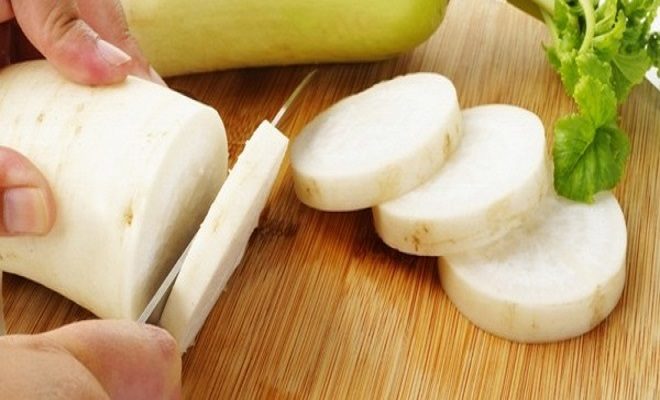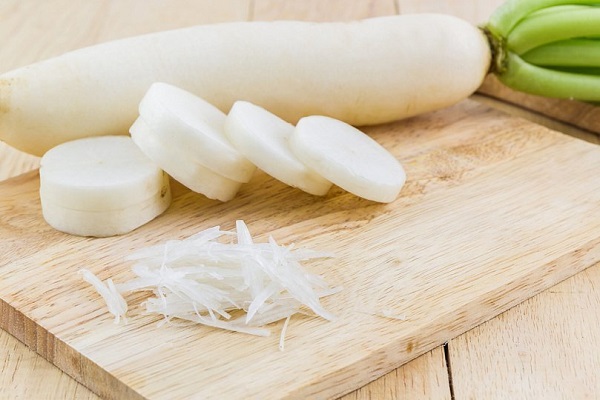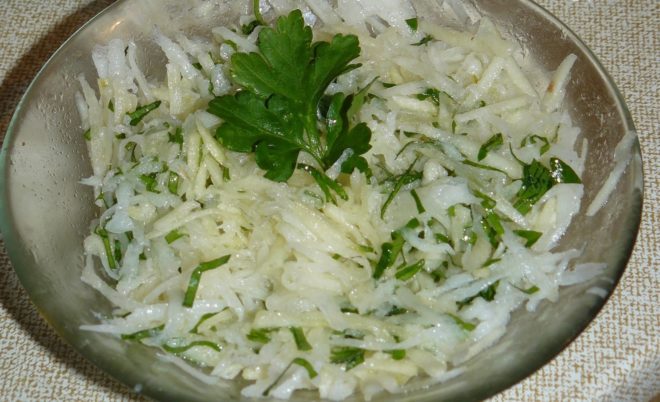Content
- 1 What is this vegetable
- 2 Composition and calorie content of white radish
- 3 Why is daikon useful?
- 4 Is daikon useful for losing weight
- 5 The use of daikon in traditional medicine
- 6 The use of white radish in cosmetology
- 7 What can be made from daikon
- 8 How to store daikon
- 9 Daikon harm and contraindications
- 10 Conclusion
Chinese radish is gaining immense popularity, especially among people who are losing weight, they know the benefits and harms of daikon. They are familiar with the amazing medicinal properties of the root vegetable. But first things first.
What is this vegetable
Daikon is a type of radish. The vegetable was obtained in ancient times in a selective way from an Asian radish called Loba. In the past few years, the daikon has become very popular in Russia.
Daikon is translated from Japanese as "big radish". There are several varieties of vegetables that differ in color.

Composition and calorie content of white radish
The root vegetable is rich in B vitamins, ascorbic acid, retinol and vitamin H. There are many minerals of potassium, magnesium, sodium, calcium and phosphorus.
The calorie content of radish is 21 kcal per 100 grams of fruit.
Why is daikon useful?
The vegetable is rich in calcium salts, which help to remove toxins from the body and excess moisture. Beta-carotene is found in large quantities. It helps to strengthen the immune system.
Of all the variety of vegetable crops, only radish, horseradish and daikon are able to cleanse the kidneys and liver of various toxins, as well as dissolve stones.
A vegetable in large quantities has phytoncides - elements that prevent the development of microbes, thereby preventing the development of infectious ailments.
For women
White radish is rich in vitamin B9 or folic acid. For the female body, this element plays a significant role in the normalization of the menstrual cycle, as well as the process of hematopoiesis in the girl's body.

For men
The vegetable contains protein that contributes to the growth of muscle mass, which means that athletes should pay special attention to the root crop.
Also, with the regular use of a vegetable, the effect of useful elements is aimed at enhancing male libido and increasing potency.
During pregnancy and breastfeeding
Women who are planning a pregnancy should increase their intake of foods with vitamin B9 in their daily diet.
As for breastfeeding, in the first two months of a baby's life, radish should not be introduced into the mother's diet. This is due to several factors:
- The mother's use of radish leads to strong fermentation in the baby's intestines, which causes colic and pain.
- Mother's milk after eating the root vegetable begins to acquire a bitter taste.
On the other hand, when properly included in the mother's diet, daikon can provide a lot of benefits, especially during winter. At the 4th month, the baby's digestive system begins to get stronger, the baby's body prepares to receive new food. At this time, this vegetable can be introduced into the mother's diet.
After that, if the baby did not have stomach problems, then you can go on. After a few tricks, you can not just drink the juice of the root vegetable, but try to use it in its natural form. First, it is recommended to eat ¼ of the whole daikon, the vegetable should be grated on a medium grater and soaked in water.
For children and the elderly
Children should be given a root crop at 3-4 years of age. There is no need to force the child. However, if he liked the vegetable, then it is important to ensure that there is no overeating, and the stomach is not clogged with a large amount of fiber.
But for the elderly, it is necessary to use the root crop with caution, since with age, digestion is weaker, and various diseases develop.
But if desired, you can drink root vegetable juice in small quantities. It is a mild laxative and diuretic.
Is daikon useful for losing weight
For weight loss, nutritionists recommend eating daikon fresh, since this way all macro- and microelements are fully preserved. It also has a minimum calorie content. Due to this feature, the root crop can be included in the daily diet of those who are losing weight.
Before going to bed, you should drink daikon juice. To do this, grate the fruit and squeeze out the juice. It costs ½ glass to drink. If the taste is unpleasant, it can be mixed with apple or carrot juice.

Regular consumption of fresh vegetable salad along with daikon will speed up the process of losing weight. It is recommended to eat a daikon at least once a week for any diet.
The use of daikon in traditional medicine
The vegetable is used in medicine for the treatment of many diseases, as well as for the general strengthening of the immune system:
- Treatment of wounds, scratches, cracks and other damage to the skin. To do this, the root crop should be grated and applied to problem areas.
- Anti-cold use. For sputum discharge, 50 grams of root vegetable juice is mixed with honey and drunk.
- For the treatment of arrhythmia, the vegetable is grated and covered with granulated sugar. Then the resulting juice should be drunk before meals, 1 tablespoon 3 times a day.
- Canned daikon can help with anemia. It is necessary to grate the radish, carrots and beets, mix and send to the oven for 3 hours. Take 1 tablespoon 3 times a day.
- For patients suffering from sciatica and rheumatism, a mixture of daikon, honey and water in a 3: 2: 1 ratio will help.
White radish for cough
White radish with honey recipe helps patients to get rid of cough. Every housewife should have it. This mixture can be taken by both adults and children.

Preparation rules:
- the top of the root crop is cut off;
- the core is scraped;
- the space is filled with honey;
- after 12 hours, the root crop begins to start up juice, which is mixed with honey.
After that, the resulting mixture can be drunk.
But there are other options for how to make daikon. For example, finely chop the peeled vegetable into cubes, put it in a container and add 3 tablespoons of honey. Close the lid and leave for 12 hours. Then you can drink the resulting juice.
The duration of treatment is 10 days. Children should drink a teaspoon 2 times daily before meals. And for adults, a tablespoon in the same way.
The use of white radish in cosmetology
In cosmetology, daikon can be used in two ways:
- As a face mask. To do this, grate the radish, add a small amount of sour cream. Spread the resulting substance in a thin layer over the surface of the face. Rinse off after 20 minutes.
- For washing. Here, root vegetable juice is used. Regular washing with juice helps to rejuvenate the skin, improve color and condition. Increases firmness.
What can be made from daikon
White radish is a root vegetable that goes well with any vegetable. Therefore, a huge variety of salads can be prepared from it. It is also combined with other products.

Daikon dishes:
- various salads;
- a meatball sandwich;
- Japanese croquettes;
- cutlets;
- aspic;
- rolls;
- steaks;
- pickle a vegetable;
- Miso soup;
- carbonara, udon;
- sushi.
How to store daikon
There are several ways to store root vegetables.
Storing fresh vegetables in the sand for the winter. Initially, the purest fruits should be selected. Then put in layers in wooden boxes. Cover each layer with wet sand. Moisten the sand regularly to keep the radish from drying out. Move the boxes to a location with low temperatures with minimal penetration of sunlight.
Storing daikon in the refrigerator. Wrap each fruit in polyethylene with small holes. Place in the vegetable compartment. Regularly assess the root crop for rot.
Storage in an apartment or closet. On the balcony, you need to cover the vegetables with a cloth so as not to freeze them. And the temperature of the closet should not exceed +8 0FROM.
Freezing. Remove petioles and rinse with daikon. Cut the fruit into small pieces, or grate. Put away in polyethylene and in a freezer.
Juice storage, canning... Steam and warm the jars. Squeeze out the juice. Pour into containers and roll up. Store in a cool, dark place.
Daikon harm and contraindications
Despite all the benefits of white radish, it also has a number of contraindications. Excessive consumption of daikon causes flatulence, irritates the mucous membrane of the digestive system.
It is recommended to use the root vegetable with caution for people suffering from gastritis, gout and ulcers.
Conclusion
The benefits and harms of daikon are now known to everyone who reads it. The root vegetable is good for everyone. But a number of people require a doctor's consultation before consuming the root vegetable. The benefits of white radish salad are both in weight loss and in the treatment and prevention of various diseases. You should also not overeat a vegetable. Everything should be in moderation.

